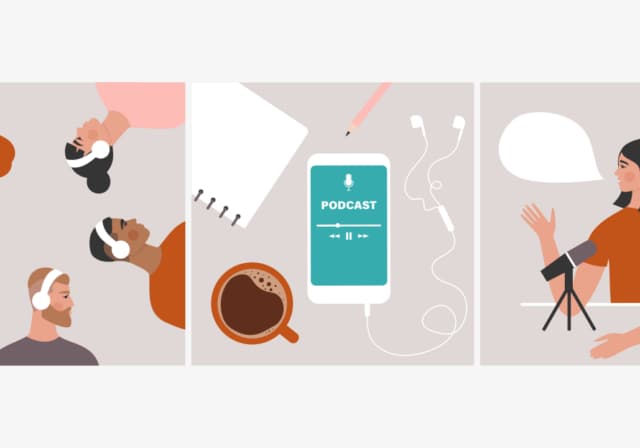With all the time we spend binge watching our go-to content, most of us would consider ourselves experts at streaming. But few of us have a knowledge of the technology that’s actually behind it. If you’re curious about how streaming works and how to make the most of your streaming capabilities, read on.
What does streaming mean? The definition
Pretty much every time you watch a YouTube video on your phone, a movie from Netflix on your tablet, or play music from Spotify while you work on your laptop, you’re streaming. The term streaming refers to any real-time delivery of audio, video, and other multimedia content to a device over the internet. Streaming allows you to watch or listen to content without having to download it to your device first.
The history of streaming
Though it’s now difficult to remember a time when our favorite movies, music, and shows weren’t available at the tap of a screen, streaming as we know it is still fairly young. One of the first ever live streams over the internet was an ESPN SportsZone radio broadcast of a Seattle Mariners vs. New York Yankees game streamed to thousands of subscribers in September 1995. The company that made this technology possible was called RealNetworks. Streaming technology like Apple's QuickTime and Microsoft's Windows Media Player soon followed, offering their own solutions for playing real-time video and audio over devices.
However, CPU and bandwidth issues were major barriers to innovation at the time. Buffering and connectivity issues also made streaming difficult for most home internet users. Improvements in broadband technology meant faster speeds and the capacity to transmit more data over the internet, which was a major step towards the path to streaming as we know it today.
In 2007, Netflix, which had previously operated as a DVD by mail service, launched its streaming service, and the “streaming wars” as we know them today officially began.
5 common streaming devices
To stream content, you need a device that can access the internet and decode the data stream. Five common streaming devices include:
- Smart TVs with built-in apps like Netflix and Hulu
- Streaming sticks like Roku, Amazon Fire TV, and Google Chromecast
- Game consoles like PlayStation and Xbox
- Mobile devices like smartphones and tablets
- Computers with web browsers or installed apps. These devices act as the interface between the streaming service and your display or speakers.
4 common streaming apps
Streaming apps are software platforms that deliver content over the internet. Most require a subscription, but some offer free tiers with ads. Here are four examples:
- Video streaming: Netflix, Hulu, Disney+, YouTube
- Music streaming: Spotify, Apple Music, Amazon Music
- Live TV: YouTube TV, Sling TV, Hulu + Live TV
- Gaming: Twitch, Xbox Cloud Gaming, Nvidia GeForce NOW. These apps make it easy to access content across devices anytime, anywhere.
Streaming vs. broadcasting
While streaming and broadcasting may sound similar, they’re quite different.
- Broadcasting is a one-to-many transmission—think traditional TV or radio. Everyone tuning in receives the exact same feed at the same time, regardless of their location or device.
- Streaming, on the other hand, is user-specific and internet-based. You choose what to watch and when to watch it. While live streams can resemble broadcasts in their real-time nature, they're still individually delivered via the internet rather than over airwaves or cable.
Streaming vs. downloading
Downloading means transferring a complete file to your device before you can access it. For example, when you download a movie, it has to fully finish before you can watch it. Streaming plays content as it downloads, in real-time. It’s more convenient and doesn’t take up storage space—but it does require a stable internet connection. Here’s a closer look:
| Feature | Streaming | Downloading |
|---|---|---|
| Internet Needed | Yes (during playback) | Only during download |
| Storage Used | Minimal | Takes up device storage |
| Access Time | Instant | Must wait for full download |
| Offline Use | No (unless saved separately) | Yes (after download completes) |
6 types of streaming content
The term “streaming” gets thrown around a lot, but it can be difficult to understand which types of content we consume is actually streaming content. Here’s a quick guide to the six different types of content that fall under the umbrella term “streaming content.”
- Live streaming: If you’ve ever watched the State of the Union on YouTube or even if you tried to watch the Love is Blind live reunion special on Netflix, then you're familiar with live streaming. This type of content is available in real-time (or with just a few seconds delay) and is a common format for live sports events, news broadcasts, or concerts.
- On-demand streaming: This type of streaming allows you to watch movies, television shows, or other types of pre-recorded content any time you want. Services like Hulu, Netflix, and other streaming services offer on-demand streaming content.
- Music streaming: This involves streaming audio content, such as music, podcasts, or radio shows, over the internet. Popular music streaming services include Spotify, Apple Music, and Pandora.
- Game streaming: Watching live video game play over the internet on popular platforms like Twitch and YouTube Gaming is one form of game streaming. However, sometimes this term is also used to refer to streaming games over the internet to mobile devices or gaming PCs.
- Webcasting: This term usually refers to streaming live events over the internet, such as business conferences or webinars.
- Podcasting: This type of audio content usually features a talk show-like format and is most commonly delivered via music streaming services like Apple Music and Spotify
How does streaming work? 5 steps
To stream a live event, music, or video, there are five steps.
- You open a streaming app or website and select the content you’d like to stream. For example, opening Netflix and choosing a movie.
- The streaming service sends a request to the server to retrieve the content.
- The server receives the request and data is sent to the device in small packets.
- The device receives the packets and then puts them in the correct order to make a cohesive streaming video or audio.
- Now you can listen or watch without interruption even if the streaming content is live.
However, there are a few factors that might affect the speed and quality of streaming content, such as the speed of your internet connection, the quality of the content being streamed, and the processing power of your device.
Here are some of the most common terms that come up in relation to streaming, along with their definitions and the ways they might affect the streaming experience.
- Compression: Streaming takes a lot of bandwidth, and when multiple devices are clamoring for bandwidth, overall internet speeds can be very slow. That’s why it’s difficult to stream a movie, join a Zoom call, and download a large file all at the same time. The goal of compression is to reduce the bandwidth required to stream so you can watch or listen without noticeable buffering.
- Buffering: We’ve all seen that annoying little “Buffering” message interrupting our streaming experience. But what exactly is buffering? Since streaming data is broken into parts that are then reassembled to create a cohesive experience, devices must have enough parts to make a whole in order to steam a file. Having a cache of these packets in advance avoids interruptions later on. The buffer is the reserved area of memory where this data is stored. Buffering means that a device is collecting enough data packets to proceed without disruptions. If a network is fast enough, then buffering is unnecessary but because packets have to travel through routers to reach their destination, not to mention share bandwidth with other devices, usually some buffering is necessary for uninterrupted streaming. Therefore, live streaming isn’t exactly instantaneous—there’s likely at least a few seconds of delay.
- Adaptive streaming: Many streaming services use adaptive bitrate streaming to judge the speed of an internet connection and adjust the quality of the stream to the speed of the connection to prevent lengthy buffering.
The technology behind streaming
Streaming uses a combination of tools that work together to seamlessly deliver content. Originally called store-and-forward video, streaming technology works by sending small packets of data over the internet to a device, then reconstructing those data packets into audio or video content that can be viewed or listened to without lags or delays.
Here are some of the key steaming technologies that make it possible to watch content almost instantly:
- Content delivery networks (CDNs): CDNs are networks of servers located around the world that help deliver content to you quickly and efficiently. When you request content, the CDN selects the server closest to you to minimize latency and buffering.
- Protocols: Streaming services use multiple protocols, such as HTTP, RTMP, and HLS, to transfer data over the internet. These protocols help ensure that data packets are delivered efficiently and securely.
3 advantages and disadvantages of streaming
Streaming obviously has tremendous advantages. Here are the three biggest perks:
- Convenience: The main advantage is that you no longer have to leave your home for quick access to a wide array of content, including movies, shows, news, and even live events.
- Mobility: Most content is available on-the-go, making it possible to listen to a favorite podcast at the gym or easily watch a movie on a plane.
- Customization: Unlike traditional media, streaming allows you to completely customize your viewing experience, whether you enjoy current events, sports, films, or any type of specialty content. It’s all available and it can even be ad-free, for a price.
However, there are three downsides to streaming:
- Siloed content: As streaming services become more and more popular, quick on-demand access to the latest entertainment has become increasingly expensive. Keeping up with all your favorite shows now requires monthly subscriptions to a multitude of platforms, which adds up quickly.
- Dependence on internet: While a great many people worldwide have access to the internet, it’s not universally available. And in remote areas without high-speed internet access, streaming is difficult due to slow internet speeds.
- Environmental impact: Streaming, along with related server farms and devices, is actually responsible for quite a lot of carbon emissions. One group of researchers estimates that YouTube is responsible for emitting so much carbon dioxide each year that it far surpasses “the equivalent greenhouse gas output of Glasgow.”
The future of streaming
Streaming has come a long way in a very short time, and that progress doesn’t seem to be slowing. Recent years have seen pretty much every major media player in the game try to get into streaming, from HBO Max to Paramount, Disney, and NBC, alongside the original monoliths of video streaming, Netflix and Amazon. And as more and more people move away from traditional cable in favor of the broader selection and ease of streaming, that growth is not likely to slow.
New technology that guarantees faster internet and better access to wireless services, such as 5G and Wi-Fi 6, also means that streaming will soon be more seamless than ever. These advancements will make streaming both more widely available and much easier.
Despite being such a new way to consume content, streaming has forever changed the ways we interact with media. And as even better streaming technology and new platforms emerge, the future of streaming seems limitless.
You might also be interested in:
- T-Mobile’s Live TV & Streaming Service Deals
- T-Mobile’s In-Flight Wi-Fi: Unlimited Internet, Streaming & Texting
- How to turn on HD video streaming on your T-Mobile device
Sources:
- https://www.cloudflare.com/learning/video/what-is-streaming/
- https://www.businessofbusiness.com/articles/a-brief-history-of-video-streaming-by-the-numbers/
- https://www.pcmag.com/picks/the-best-media-streaming-devices
- https://eventagrate.com/blog/broadcasting-vs-streaming-understanding-the-landscape
- https://www.lifewire.com/difference-between-streaming-and-downloading-media-1847372
- https://books.google.com/books
- https://www.theguardian.com/media-network/media-network-blog/2013/mar/01/history-streaming-future-connected-tv
- https://getstream.io/blog/streaming-protocols/
- https://www.theguardian.com/tv-and-radio/2021/oct/29/streamings-dirty-secret-how-viewing-netflix-top-10-creates-vast-quantity-of-co2
- https://www.wired.co.uk/article/youtube-digital-waste-interaction-design
- https://www.pcmag.com/encyclopedia/term/streaming-ap
- https://greenly.earth/en-us/blog/industries/whats-the-environmental-impact-of-streaming
- https://www.theguardian.com/tv-and-radio/2021/oct/29/streamings-dirty-secret-how-viewing-netflix-top-10-creates-vast-quantity-of-co2
- https://www.wired.co.uk/article/youtube-digital-waste-interaction-design





